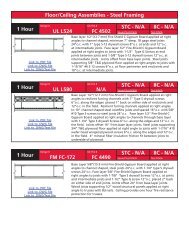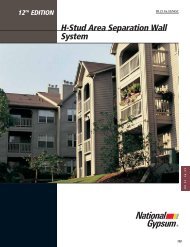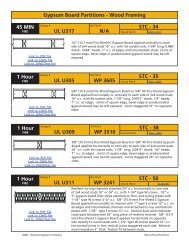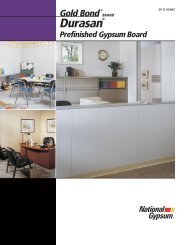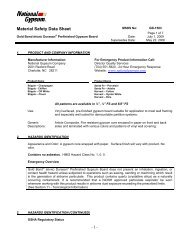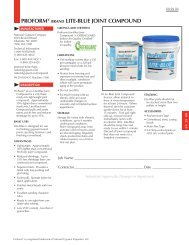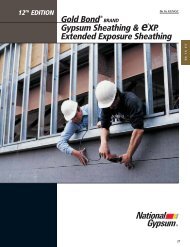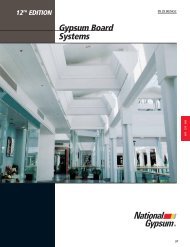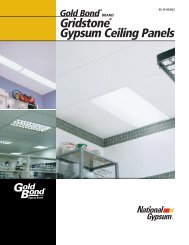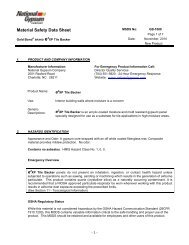National Gypsum Construction Guide - 12th Edition
National Gypsum Construction Guide - 12th Edition
National Gypsum Construction Guide - 12th Edition
Create successful ePaper yourself
Turn your PDF publications into a flip-book with our unique Google optimized e-Paper software.
METRIC CAPABILITIES<br />
The Federal Government has<br />
mandated that each federal<br />
agency make a transition to<br />
the use of metric units in<br />
all federal procurement,<br />
grants and business-related<br />
activities. <strong>National</strong><br />
<strong>Gypsum</strong> Company, in<br />
complying with this order,<br />
provides a full line of gypsum<br />
board products in<br />
“hard” metric dimensions<br />
with regard to width and<br />
length. Standard board<br />
offerings are made in the<br />
width of 1200 mm and a<br />
length of 3600 mm. Job<br />
size lengths are available<br />
on a special order basis<br />
requiring minimum orders<br />
and extended lead times.<br />
Contact your local<br />
<strong>National</strong> <strong>Gypsum</strong><br />
Company representative for<br />
further information.<br />
Thickness of gypsum board<br />
will be “soft” converted to<br />
the metric equivalent.<br />
ENVIRONMENTAL<br />
CONDITIONS<br />
Maintain a room temperature<br />
of not less than 40˚F (4˚C)<br />
during application of gypsum<br />
board except when<br />
adhesive is used for the<br />
attachment of gypsum<br />
board. For the bonding of<br />
adhesive, joint treatment,<br />
texturing, and decoration,<br />
the room temperature shall<br />
be maintained at least at<br />
50˚F (10˚C) for 48 hours<br />
prior to application and<br />
continuously thereafter<br />
until completely dry.<br />
Note 1: Precaution–When a<br />
temporary heat source is<br />
used, the temperature shall<br />
not exceed 95˚F (35˚C) in<br />
any given room or area.<br />
Note 2: Precaution–Maintain<br />
adequate ventilation in the<br />
working area during installation<br />
and curing period.<br />
Protect gypsum board products<br />
from direct exposure to rain,<br />
snow, sunlight, or other<br />
excessive weather conditions.<br />
GUIDELINES FOR<br />
PREVENTION OF MOLD<br />
GROWTH ON GYPSUM<br />
BOARD<br />
<strong>Gypsum</strong> board does not generate<br />
or support the<br />
growth of mold when it is<br />
properly transported,<br />
stored, handled, installed,<br />
and maintained. However,<br />
mold spores are present<br />
everywhere and when<br />
conditions are favorable,<br />
mold can grow on practically<br />
any surface.<br />
Observing these guidelines<br />
will help minimize<br />
the potential for mold<br />
growth on gypsum board.<br />
<strong>Gypsum</strong> board must be<br />
kept dry to prevent the<br />
growth of mold.<br />
Transportation and Receiving<br />
<strong>Gypsum</strong> board must be protected<br />
during transit with a<br />
weather-tight cover in<br />
good condition.<br />
Plastic shipping bags are<br />
intended to provided protection<br />
during transit only<br />
and must be promptly<br />
removed upon arrival of<br />
the load. Failure to<br />
remove the shipping bag<br />
can increase the likelihood<br />
of developing conditions<br />
favorable to the<br />
growth of mold.<br />
Storage and Handling<br />
<strong>Gypsum</strong> board must be<br />
stored in an area that protects<br />
it from adverse<br />
weather conditions, condensation,<br />
and other forms<br />
of moisture.<br />
Job site conditions that can<br />
expose gypsum board to<br />
water or moisture must be<br />
avoided.<br />
<strong>Gypsum</strong> board must be<br />
delivered to the job site as<br />
near to the time it will be<br />
used as possible.<br />
Application<br />
Provisions must be made to<br />
keep gypsum board dry<br />
throughout application.<br />
<strong>Gypsum</strong> board that has visible<br />
mold growth must not<br />
be used.<br />
<strong>Gypsum</strong> board on walls must<br />
be applied with a minimum<br />
1/4" (6.35 mm) gap<br />
between the gypsum<br />
board and the floor.<br />
<strong>Gypsum</strong> board must not be<br />
applied over building<br />
materials where conditions<br />
exist that are favorable<br />
to mold growth.<br />
Maintenance Following<br />
Application<br />
Essential elements of sound<br />
weather tight building<br />
envelope must be properly<br />
maintained, such as the<br />
roof, sealants, windows,<br />
etc.<br />
Immediate and appropriate<br />
remediation measures<br />
must be taken as soon as<br />
water leaks or condensation<br />
sources are identified.<br />
Routine cleaning and maintenance<br />
operations must be<br />
performed so as to prevent<br />
saturation of the gypsum<br />
board.<br />
Additional Sources of<br />
Information<br />
The following Web sites provide<br />
information and recommendations<br />
for treating<br />
mold growth; other sites<br />
also provide similar suggestions.<br />
California Indoor Air Quality<br />
Program at<br />
http://www.cal-iaq.<br />
org/iaqsheet.html<br />
Federal Emergency<br />
Management Agency at<br />
http://www.fema.gov/<br />
pdf/hazards/fststpbr.html<br />
New York City Department<br />
of Health at<br />
http://www.ci,nyc.ny.<br />
us/html/doh/html/epi/<br />
moldrpt1.html<br />
U. S. Environmental<br />
Protection Agency at<br />
http://www.epa.gov/<br />
iedweb00/pubs/<br />
moldresources.html<br />
GA-238, Copyright <strong>Gypsum</strong><br />
Association<br />
09 29 00/NGC<br />
LIMITATIONS<br />
1. Maximum stud spacing for<br />
single layer application of<br />
1/2" and 5/8" gypsum board<br />
is 24" o.c. If 3/8" gypsum<br />
board is used, it must be<br />
applied in two layers, with<br />
the second layer adhesively<br />
applied; 24" o.c. stud spacing<br />
may be used.<br />
2. Where long, continuous runs<br />
of this wall system are<br />
employed, control joints must<br />
be provided every 30' or less.<br />
3. Where structural movement<br />
may impose direct loads on<br />
these systems, isolation<br />
details are required.<br />
4. Partitions should not be used<br />
where frequently exposed to<br />
excessive moisture unless all<br />
surfaces are waterproofed.<br />
5. To prevent weakening due<br />
to calcining, gypsum board<br />
should not be exposed to<br />
temperatures over 125˚F<br />
(52˚C) for extended periods<br />
of time.<br />
6. <strong>Gypsum</strong> board joints on single<br />
layer, or the face layer<br />
on two layer applications,<br />
shall not occur within 12" of<br />
the corners of door frames<br />
unless control joints are<br />
installed at the corners.<br />
7. When gypsum board abuts<br />
concrete floors, cut board to<br />
allow for 1/8" to 1/4" clearance<br />
between board and<br />
floor to prevent potential<br />
wicking.<br />
NATIONAL GYPSUM BOARD PRODUCTS<br />
63<br />
09 29 00



